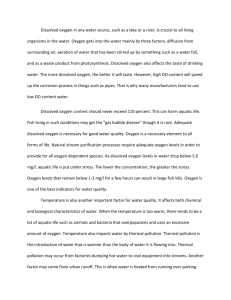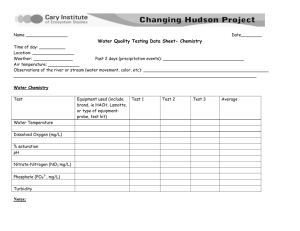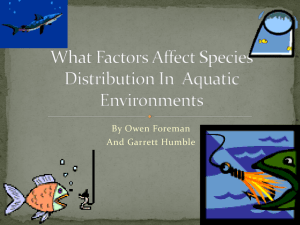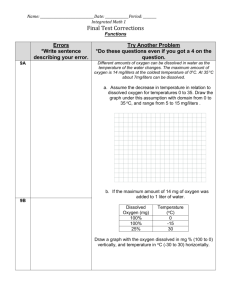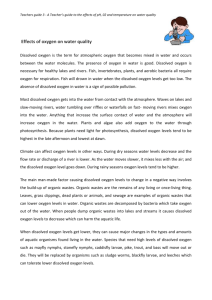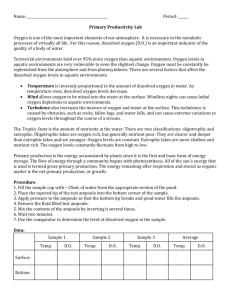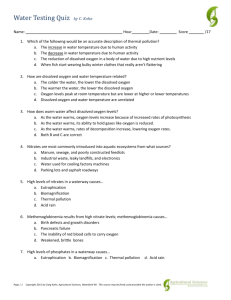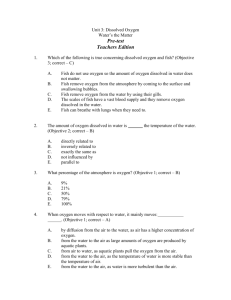Water Quality 101: Dissolved Oxygen
advertisement
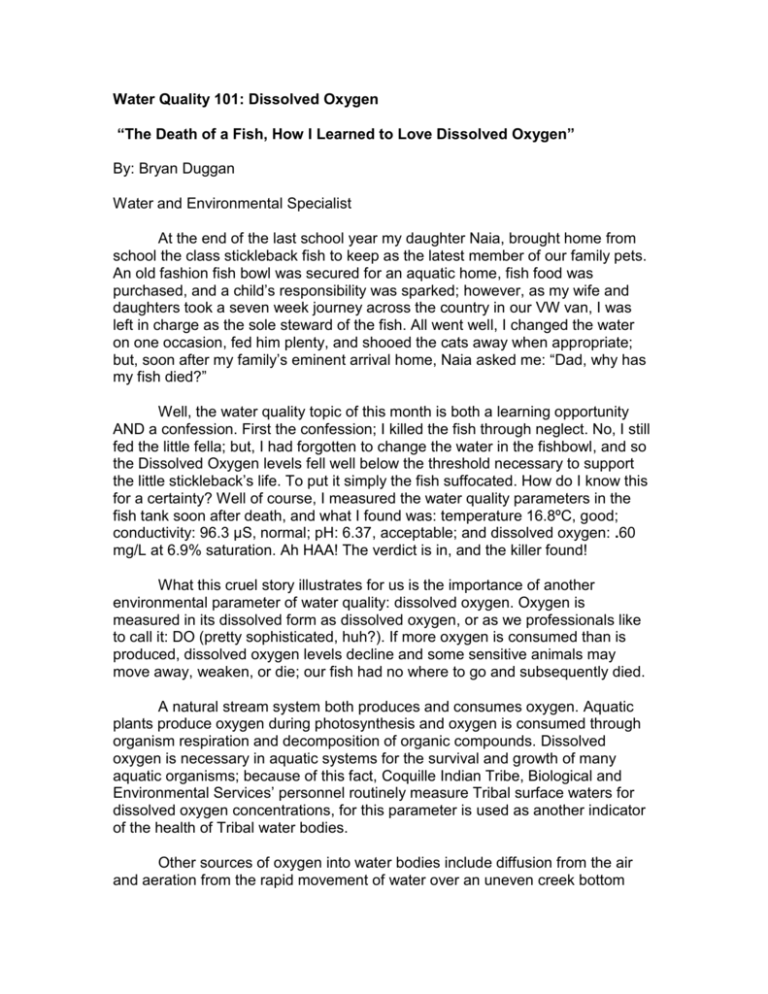
Water Quality 101: Dissolved Oxygen “The Death of a Fish, How I Learned to Love Dissolved Oxygen” By: Bryan Duggan Water and Environmental Specialist At the end of the last school year my daughter Naia, brought home from school the class stickleback fish to keep as the latest member of our family pets. An old fashion fish bowl was secured for an aquatic home, fish food was purchased, and a child’s responsibility was sparked; however, as my wife and daughters took a seven week journey across the country in our VW van, I was left in charge as the sole steward of the fish. All went well, I changed the water on one occasion, fed him plenty, and shooed the cats away when appropriate; but, soon after my family’s eminent arrival home, Naia asked me: “Dad, why has my fish died?” Well, the water quality topic of this month is both a learning opportunity AND a confession. First the confession; I killed the fish through neglect. No, I still fed the little fella; but, I had forgotten to change the water in the fishbowl, and so the Dissolved Oxygen levels fell well below the threshold necessary to support the little stickleback’s life. To put it simply the fish suffocated. How do I know this for a certainty? Well of course, I measured the water quality parameters in the fish tank soon after death, and what I found was: temperature 16.8ºC, good; conductivity: 96.3 µS, normal; pH: 6.37, acceptable; and dissolved oxygen: .60 mg/L at 6.9% saturation. Ah HAA! The verdict is in, and the killer found! What this cruel story illustrates for us is the importance of another environmental parameter of water quality: dissolved oxygen. Oxygen is measured in its dissolved form as dissolved oxygen, or as we professionals like to call it: DO (pretty sophisticated, huh?). If more oxygen is consumed than is produced, dissolved oxygen levels decline and some sensitive animals may move away, weaken, or die; our fish had no where to go and subsequently died. A natural stream system both produces and consumes oxygen. Aquatic plants produce oxygen during photosynthesis and oxygen is consumed through organism respiration and decomposition of organic compounds. Dissolved oxygen is necessary in aquatic systems for the survival and growth of many aquatic organisms; because of this fact, Coquille Indian Tribe, Biological and Environmental Services’ personnel routinely measure Tribal surface waters for dissolved oxygen concentrations, for this parameter is used as another indicator of the health of Tribal water bodies. Other sources of oxygen into water bodies include diffusion from the air and aeration from the rapid movement of water over an uneven creek bottom (aka: rapids or riffles). As we all know, the air we breathe contains 21% oxygen, while surface water contains less than 1% oxygen. Where the air and water meet, this tremendous difference in concentration causes oxygen molecules in the air to dissolve into the water. Additional oxygen dissolves into water when wind stirs the water; as the waves create more surface area, more diffusion can occur. A similar process happens when you add sugar to a cup of coffee - the sugar dissolves. It dissolves more quickly, however, when you stir the coffee. DO is measured both as milligrams per liter (mg/L) and "percent saturation." A milligram per liter is the amount of oxygen in a liter of water. Percent saturation is the amount of oxygen in a liter of water relative to the total amount of oxygen that the water can hold at that temperature. As this suggests, there is a direct relationship between the temperature of water and the concentration of oxygen; cold water dissolves more oxygen than warm water. Aquatic animals are most vulnerable to lowered DO levels in the early morning on hot summer days when stream flows are low, water temperatures are high, and aquatic plants have not been producing oxygen since sunset. The impacts of pollution on dissolved oxygen concentrations are determined by the presence of certain kinds of microorganisms, and the type of organic and inorganic materials in the water. Wastewater from sewage treatment plants often contain a large amount of organic materials that when present, stimulate a rapid growth in bacterial microorganisms. These microorganisms use oxygen in the decomposition process; and can often lead to a rapid depletion of oxygen resources within the water and subsequent fish kills. Other sources of oxygen-consuming waste include nutrient heavy stormwater runoff from farmland or urban streets, feedlots, and failing septic systems. Similar to the wastewater scenario, abundant nutrient levels fuel uninhibited algae blooms which lead to a phenomenon called hypoxia. Hypoxia occurs when algae and other organisms die, sink to the bottom, and are decomposed by bacteria, again over using the available dissolved oxygen. As with water pH, there is an optimal range of DO for sustaining aquatic life within surface waters. Typically Tribal surface waters contain 7-10 mg/L of DO at 70-92% saturation. Dissolved oxygen should not exceed 110% saturation; above this concentration fish may develop “gas bubble disease” where the excessive oxygen bubbles block the flow of blood through the organism’s blood vessels causing death. As dissolved oxygen levels in water drop below 5.0 mg/l, aquatic life is put under stress; the lower the concentration, the greater the stress. Oxygen levels that remain below 1-2 mg/l for a few hours can result in large fish kills. Here is where we return to the scene of the crime, being in a tank of water without an adequate aeration device to facilitate oxygen diffusion resulted in lower dissolved oxygen concentrations over time, as the fish consumed the available oxygen up to and beyond the threshold necessary for aquatic life the stickleback could not escape it’s deteriorating environment to maintain it’s life processes, and thus perished. So it is with great interest that we routinely monitor and track the dissolved oxygen trends within Tribal surface waters. As with the other water quality parameters we have been discussing over the last months, the quantitative information of dissolved oxygen clues us into the environmental health of the aquatic ecology; which if found deteriorating, can enable us to act appropriately to protect and restore the ecological functionality of the aquatic systems under our stewardship.
